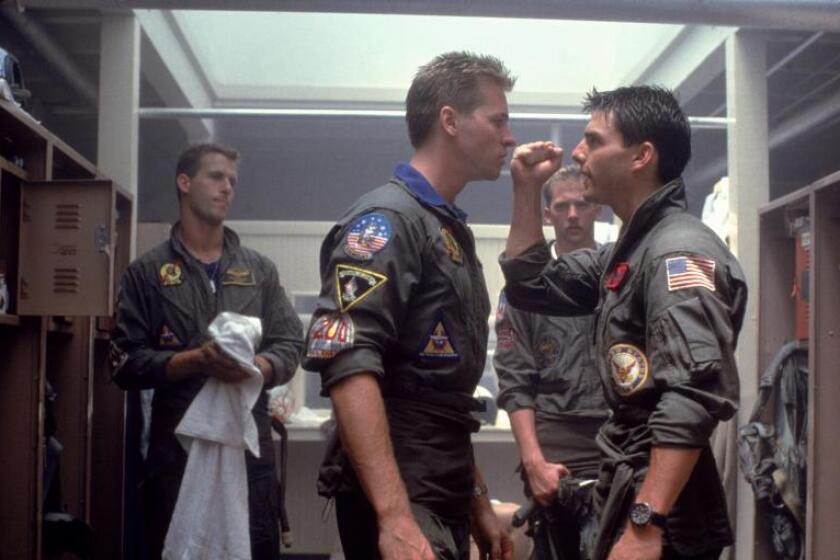
- Share via
“Warfare” wants to live in the dictionary shoehorned between war cry and war hawk. This short and gripping thriller nails its Oxford English definition — “the activity of fighting a war” — while stripping away the clichés that have come to signify a Hollywood war movie. There are no speeches, no teachable moments of the farm boy and the Brooklyn kid learning to depend on each other, and not one instance of someone brandishing a photo of their sweetheart and promptly getting blown to smithereens. “Warfare” is strictly the facts, and those alone are terrible, brave, intense, random, tedious and captivating.
Alex Garland, who co-wrote and directed the film with former Navy SEAL Ray Mendoza, attempted a similar exercise with last year’s “Civil War,” an apolitical nightmare about the United States shooting itself to bloody shreds. That nail-biter, like this one, uses violence to argue for nonviolence while dodging any polarizing specifics about why our country is bleeding. The goal is to welcome everyone into the theater and then ask if this is really what we want.
Here, we’re plunged into a reenactment of a real instance of combat in Ramadi, Iraq, on Nov. 19, 2006, during a stretch in which 75 Americans and countless Iraqis died. The carnage on this particular Sunday afternoon wasn’t the worst day of bloodshed, just one that upended lives without making headline news.
Mendoza was there when his platoon took over an Iraqi home for a lookout and then came under heavy fire. He’s played onscreen by D’Pharaoh Woon-A-Tai (“Reservation Dogs”), a steady presence on a walkie-talkie narrating the team’s activities and position — he’s essentially a verbal shot list of the action. One of Mendoza’s friends, Elliot Miller, was badly injured in the battle and woke up from a coma unable to remember what happened. “Warfare” is Mendoza and his fellow corpsman combining their memories to tell Miller, and us, how that attack looked, felt and sounded. If you use your imagination, you can smell the ash too.
The London-born actor is distinctive in a flurry of recent work, including the movies ‘Warfare’ and ‘Death of a Unicorn,’ plus a new episode of ‘Black Mirror.’
The cast is stacked with young actors who are one klick away from mainstream recognition: Will Poulter, Charles Melton, Joseph Quinn, Cosmo Jarvis, Noah Centineo and Michael Gandolfini. Together, they’re a yearbook photo of future stars, like how four decades ago “The Outsiders” rounded up Patrick Swayze, Rob Lowe, Matt Dillon, Ralph Macchio, Emilio Estevez and Tom Cruise. They’re all good — from the wounded combatants who spend half of the movie in so much agony they’re nonverbal to the bit players like Gandolfini who only register for a scene or two of panic. “Warfare” won’t do much for any of their individual careers. Their impact is in the collective unity of their matching buzzcuts and goofy senses of humor. Their unit barges into the action already so intimately familiar with one another that you have to be lasered in just to catch their characters’ names.
Our first image is a fake-out: a somber black screen telling us the date and place that smash-cuts to a corny exercise video of a gym-bunny blond in a thong. “Warfare” premiered in the same theater as the candy-colored aerobics of “The Substance” and, for a disorienting moment, I wondered if the projectionist had swapped in the wrong reel. Then the camera spins around to reveal a room of soldiers hooting at these sexy squats, partying as hearty as if this were a nightclub in Ibiza, not an outpost in the War on Terror. It’s the only scene of its kind in the movie, but the point is made: “Warfare” will not feel like homework. It’s also the only scene where these guys aren’t on the clock — they’re simply men hanging out before they have to go to work.
The predawn scenes have a fragmented, almost experimental editing style. In the darkness, when we’re still trying to get our bearings, the group occupies a home in Ramadi before we think to ask who lives there and why they’re getting their walls smashed in. In the daylight, it’s clearer that the SEALs are holding an ordinary family at gunpoint — a husband and wife and two daughters — while they take up positions upstairs.
Is this a defensive or offensive mission? Is there a distinction? That goes undiscussed, but we pick up that Poulter leads one platoon and Melton, another. Jarvis (“Shōgun”) plays Miller, a sniper perched atop a stack of mattresses, and even before you connect that the movie is dedicated to him, he’s such a bearish and jolly actor that he claims your attention, even as he keeps his eye on the movements of the unknown Iraqis in his crosshairs, nose smushed so firmly into the stock of his rifle that you can sense itchy beads of sweat in his mustache.
Writer-director Alex Garland’s controversy-courting political fable about a violently divided America brings together two generation-defining actors.
We’re waiting alongside the SEALs to see what will happen. The life-or-death monotony has everyone on edge. We feel the pressure of sore backs and full bladders. There’s no music to hint when the violence is coming. Instead, we stare at the strangers in Miller’s scope (Is that guy looking our way?), alert for whatever interrupts the silence: the scratch of pens on maps, Mendoza’s continual patter to whoever’s listening, the men breathing and the dogs barking outside. (Are they barking too much?)
And then the carnage begins. The images are surreal: choked black skies, unnerving moon-like suns, a mangled foot that wraps around the corner of a hallway like it has no bones. Worse, sound designers Glenn Freemantle and Ben Barker have honed the menace of each bullet, and these nerve-rattling plinks build to the thunder of a low-flying jet that kicks up a maelstrom of sand. There are explosions that make the world go mute — the dullness of a concussion. Soft screams ripple in from far away. A man realizes his legs are on fire. Then all the shrill noise of combat hits the ears at once and you understand how impossible it is to make sense of anything. The fastidious Mendoza needs to get his platoon rescued but he can’t concentrate on coordinates. “Look for the blood and smoke!” he pleads.
People act heroically and they make mistakes. Neither action is judged. The only SEAL who gets our hackles up acts like he’s in a rousing hooyah picture and assures a wailing man that his shattered lower body is just “a paper cut.” One of the best stretches of the film is arguably its most aggravating, with several of the men realizing they’ve left their weapons in a room that’s under siege. They go in, they go out, they remember something else they need, they go in again. Despite the imminent threat of death, the torment is human-sized, relatable to anyone who’s tried to rally a toddler to get in the car.
“Warfare” is so sparse and neutral that the audience notices what’s missing. The platoon is so focused on exiting this house that no one mentions the Iraqi family who will be left behind in the rubble, or what happened to the local interpreters who had concerns about the plan. What even is the plan beyond this day, this week, this month? Why this home, why this town? Why have any of the men enlisted? Why are they here?
That question — why? — was the focus of an entire WWII propaganda film series by Frank Capra that ran from 1942 to 1945 called “Why We Fight.” But I suspect Mendoza and Garland know a chunk of today’s audience will tune out any answer they give. So they’ve redefined their parameters. This is what warfare is. Leave the theater knowing exactly what it means to ask people to do it.
'Warfare'
Rated: R, for intense war violence and bloody/grisly images, and language throughout
Running time: 1 hour, 34 minutes
Playing: In wide release Friday, April 11
More to Read
Only good movies
Get the Indie Focus newsletter, Mark Olsen's weekly guide to the world of cinema.
You may occasionally receive promotional content from the Los Angeles Times.













